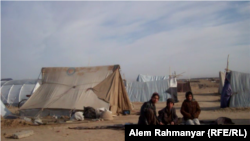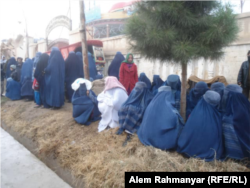SHEBERGHAN, Afghanistan -- Schoolteacher Asadullah, 45, is among thousands of Afghan civilians who have fled persecution by Islamic State (IS) militants in a remote province of northern Afghanistan.
Asadullah, who goes by one name only like many in Afghanistan, says constant threats from IS fighters forced him to leave his village, Khoja Arab in Jawzjan’s restive Darzab district, two months ago. He now rents a ramshackle house in the provincial capital of Sheberghan to provide shelter for his mother, wife, and four children.
"All schools in Darzab are shut. Teachers and students cannot go to school. We ran away from Daesh,” he told Radio Free Afghanistan, referring to IS with the Arabic acronym commonly used to identify the hard-line group in Afghanistan.
Local authorities say the closure of more than 58 local schools in Darzab district has affected more than 30,000 students.
Asadullah says IS fighters demand extortion, which sometimes exceeds hundreds of dollars in the local currency.
“If you refuse to pay, they will set your house on fire,” he said. “They randomly slaughter cows and sheep, which are precious possessions for locals to feed their soldiers."
Many residents of Darzab and neighboring Qush-Teppa have similar complaints. They say civilians have suffered after IS militants joined some renegade Taliban in Darzab two years ago. They now appear to have established a resilient enclave after resisting government forces and Taliban assaults.
Abdul Jalil, a farmer in Darzab’s Moghul village, says IS militants forced him to flee this fall.
“Daesh militants are both foreigners and locals. They include Uzbeks, Tajiks, and others,” he told Radio Free Afghanistan. “They are defaming Islam by making people homeless.”
A community elder from Darzab says that IS has overtaken the whole region. He requested his identity be withheld to avoid reprisals by the militants.
He told Radio Free Afghanistan that young bearded IS fighters riding on motorbikes are a frequent sight in Darzab.
"They simply grab cattle from locals by terming it as booty. They threaten and killed those who work with the government,” he said. “They don't let locals carry their belongings from one place to another. They even take away the salaries of local teachers [who typically earn less than $150].”
He says groups of fighters randomly descend on civilian homes to demand food.
"After evening prayer, they suddenly arrive at local houses. Irrespective of whether they are rich or poor, the militants order them to prepare food for groups larger than 50 people,” he said. “They warn that if anyone fails to comply they will be slaughtered.”
Mohammad Sadiq’s escape from Sardara village in Darzab was harrowing.
“The whole area was taken by Daesh fighters. There was fighting for three days. My brother-in-law was killed, and our house was completely destroyed,” he told Radio Free Afghanistan. “That day, taxi fares to Sheberghan jumped to 2,000 Afghanis [$30] per person from 200 Afghanis [$3]. Still, we could not find any vehicle, so I hid in the house of our relatives [in a nearby village].”
According to Jawzjan Governor Lutfullah Azizi, IS militants are still competing against Taliban fighters.
"There are more than 500 IS fighters and between 600 and 700 Taliban fighters in Darzab,” he said. “They frequently fight against each other.”
Local officials say that most areas in Darzab are controlled by IS militants save for the district compound and a few outposts.
Rehmatullah Hashar, a former district governor of Darzab, says Uzbekistani fighters form the core of IS ranks in the region. He says they are boosted by Abdul Malik. His father, Tohir Yuldash, led the Islamic Movement of Uzbekistan (IMU) until his death in northern Pakistan in 2009.
The presence of battle-hardened Central Asian fighters in Jawzjan, which borders Turkmenistan, now apparently worries Russia, which views Central Asia as its soft underbelly.
Zamir Kabulov, Russian President Vladimir Putin’s special envoy for Afghanistan, recently voiced concern over the IS presence in northern provinces bordering Tajikistan, Uzbekistan, and Turkmenistan.
Kabulov claimed the number of IS fighters now exceeds 10,000 in Afghanistan because new fighters are arriving from Syria and Iraq.
"Russia was among the first to be sounding the alarms in connection with the emergence of Daesh in Afghanistan,” Kabulov told the Sputnik news agency. “Daesh has significantly increased its power in the country recently.”
Afghan authorities, however, reject such claims.
"The number of IS fighters in Afghanistan is not in the thousands but only a few hundred. If we take Daesh into consideration from the beginning [in 2014], they might have been between 6,000 and 7,000 people,” said Afghan Defense Ministry spokesman Dawlat Waziri. “But thousands of these have been killed or captured [during the past two years].”
The IS affiliate in Afghanistan and Pakistan emerged in late 2014 and formally announced their presence in early 2015 as the Islamic State Khorasan Province, which is sometimes referred to as ISIS-K in U.S. government reports.
During summer 2015, it swept several districts of eastern Nangarhar Province along the county’s border with Pakistan. U.S. and Afghan forces are still fighting the group in Nangarhar’s mountain districts.
“From June 1, 2017, to November 24, 2017, [Special Operations Joint Task Force – Afghanistan] SOJTF-A components conducted 2,175 ground operations and 261 kinetic strikes in which they enabled or advised ASSF units,” noted a Pentagon report to U.S. Congress this month while referring to the Afghan Special Security Forces by its acronym.
“These operations included 420 ground operations and 214 air strikes against ISIS-K, resulting in more than 174 ISIS-K killed-in-action,” the report added. “Although weakened, ISIS-K will most likely continue to plan and execute high-profile attacks in populated areas.”
Back in Jawzjan, officials say they are preparing for a major military operation to cleanse Darzab and Qush-Teppa of IS.
For now, many displaced Darzab residents like Abdul Jalil can only wait.
"Now the Daesh militants issue a death sentence on a daily basis,” he said. “After the government operation, Daesh and the Taliban will take over the areas again. We cannot go back; we're scared.”









